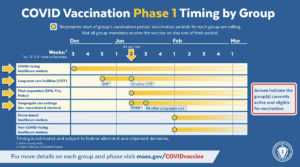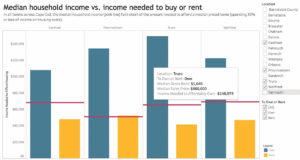PROVINCETOWN — The Cape Cod Commission plays an unusual role in the life of the Cape. It’s a kind of hybrid — part technical adviser, part regulator, part community planning agency — with a goal of keeping the 15 towns here in dialogue with each other, the public, and the natural capacities of this giant sandbar in the Atlantic.
Providing high-quality data to town governments and the public has always been part of the commission’s job. Since the Covid pandemic began, however, the commission has stepped up both data collection and data presentation efforts, to provide information that policymakers might need.
The commission rolled out its new datacapecod.com website last year, and it has a wealth of information about our towns. Much of it is drawn from the American Community Survey, which is a rolling, years-long sampling project conducted by the Census Bureau. Every year about 1 percent of the U.S. population participates in the ACS, and its reports are based on cumulative five-year totals.
“We conceived of this project as Covid-specific,” said Jen Clinton, a community development planner at the commission, “but as more requests for information popped up over time, we broadened it” — to include things like employment rates, wage information, and housing costs.
One inescapable takeaway from a look at the data: housing prices are not connected to local incomes. The gap between median income of local residents and median house prices across the Outer Cape is massive.

Datacapecod.com pulls the income and housing information together clearly. Looking at Provincetown’s employment chart, it’s clear that jobs are concentrated in just a few industries, with an average monthly wage of around $3,000. Median home prices, though, were around $600,000 in 2019, before the pandemic. Following the rule of thumb that no more than 30 percent of household income should go to housing, that median price implies an income of $11,500 a month. It would take almost four adults earning average Provincetown wages to buy a median home here.
Another panel makes this relationship between earnings and home prices clearer.

This graph relies on median household income. A household often has two earners, but sometimes just one. The median household income in each of the four Outer Cape towns is only around half of what would be needed to buy the median-price home in each town.
The Cape Cod Commission is hardly alone in noticing that local incomes and local housing prices are disconnected. By presenting detailed employment statistics for each individual town, however, DataCapeCod provides a precise look into the data that hadn’t been accessible before.
StatsCapeCod.org is an earlier Cape Cod Commission website that Clinton is hoping to merge into DataCapeCod soon. A map from StatsCapeCod shows owner-occupied housing across the Cape. In North Truro and parts of Provincetown, less than 20 percent of the housing stock is owner-occupied.

According to the census data that the commission used to make these maps, renter-occupied housing is a small fraction of the owner-occupied numbers. Even when owners and renters are combined, only about a third of housing units on the Outer Cape are occupied full-time.
Estimating Vaccine Populations
Clinton is currently working on using some of these same data sources to estimate how many people in each town will fall into various parts of Phase Two Covid vaccination plans. The first stage of Phase Two is for people 75 years old and older, followed by people 65 and older, and people with two or more co-morbidities, as defined in a CDC list of conditions that make serious illness from Covid more likely.
After that, the next stage involves a wide range of workers who are Covid-facing, including teachers, transportation and sanitation workers, and food service and retail workers. Clinton is using census data and employment statistics to estimate how many people might become vaccine-eligible at these various stages of Phase Two.
Also of interest are the existing data on households without vehicles. Many people on the Outer Cape don’t have cars, especially in Provincetown, and leaders have cited this as one reason why it’s important to have vaccination sites on the Outer Cape, not just in Orleans and Hyannis.
According to DataCapeCod, there are 211 households in Provincetown without a vehicle, 72 in Eastham, 23 in Truro, and 41 in Wellfleet. Those numbers are drawn from the American Community Survey, and they can’t be understood as perfectly precise, according to Clinton. Nonetheless, they’re a starting point for understanding who lives here and what they might need as vaccine rollout begins in earnest.
“We’re proud that people are finding this data useful,” said Clinton, “and we are open to new ideas, too. If there’s something people out there think we could do a good job researching, they can reach out to the commission and we’ll take a look at it.”



